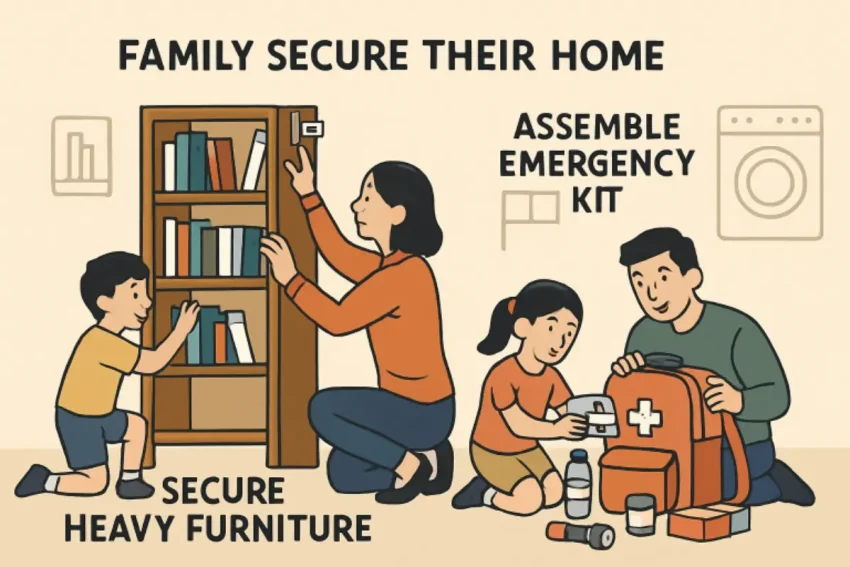Seismic Safety at Home: Practical Steps for Every Household

Earthquakes are unpredictable natural events that can cause severe damage to homes and result in injuries to occupants. Many homeowners underestimate the risks until it’s too late, making preparation not just smart but essential. One of the best ways to protect your home against earthquake damage is through a seismic retrofit, a process that strengthens a building’s structure to withstand the shaking of a major quake.
These upgrades, along with day-to-day safety habits, are crucial in enhancing both property and personal safety. Being proactive in addressing your home’s vulnerabilities can make a significant difference when the unexpected occurs.
Earthquake safety isn’t just for those living in high-risk areas. Minor tremors can cause substantial damage, especially in older homes or those not built to modern standards. Simple actions, such as securing furniture, preparing an emergency kit, and practicing family drills, can play a vital role in survival and recovery. Take the time to understand your local risks and invest effort in making your household resilient. These measures provide peace of mind, knowing that your family and property are better protected against seismic events.
Contents
Assessing Your Home’s Structural Integrity
The first step toward earthquake readiness is ensuring your home can withstand significant shaking. Homes constructed prior to the introduction of modern building codes are especially at risk, as they may lack essential reinforcements. Hiring a structural engineer for an assessment is highly recommended, as they can identify weaknesses such as unsecured foundations, old cripple walls, or unreinforced chimneys. Solutions may include anchoring your house to its foundation and adding plywood to crawl spaces.
Even newer homes can benefit from professional advice to address lesser-known vulnerabilities. For more guidance on identifying structural vulnerabilities, consult the FEMA Earthquake Risk Management resources. Taking action now can significantly reduce damage and protect your family during a seismic event. Investing in these precautions not only enhances safety but can also increase your home’s long-term value.
Securing Heavy Furniture and Appliances
Loose objects become hazards during an earthquake, leading to injuries or blocking escape routes. Securing your possessions should include:
- Anchoring bookcases, entertainment centers, and other tall furniture to studs with wall straps or brackets.
- Strapping major appliances, such as refrigerators and water heaters, to walls or floors.
- Placing non-slip mats under smaller appliances and electronics.
- Setting heavy or breakable objects on lower shelves and using safety latches on cabinets to keep contents contained.
Taking these measures minimizes the risk of falling objects and provides safer pathways for evacuation or moving to cover during an earthquake.
Developing a Family Emergency Plan
An effective family emergency plan ensures that every member of your household knows how to respond in the event of an earthquake. Start by designating safe spots throughout your home. These include places away from windows and heavy objects, like under sturdy tables or against interior walls.
Establish a communication plan—cell service may be unreliable, so pick an out-of-area contact person everyone can update. Map out evacuation routes and select a safe meeting place outside the home, such as a neighbor’s yard or local park. Regularly practice earthquake drills under varying conditions, such as at night or when family members are in different rooms, to enhance your family’s preparedness.
Assembling an Emergency Kit
Your emergency kit should contain supplies to support your family for several days, as assistance may take time to arrive. Pack at least one gallon of water per person per day for three days, non-perishable food, a flashlight with spare batteries, a battery- or crank-powered radio, and a fully stocked first aid kit. Include any prescription medications, necessary medical devices, and personal hygiene supplies.
Copies of crucial documents—such as identification, insurance policies, and medical records—should be sealed inside a waterproof pouch. Don’t forget comfort items for children and pets, if applicable. Ensure your kit is easily accessible and all family members are familiar with its location and contents.
Staying Informed and Engaged
Awareness is a key component of earthquake preparedness. Sign up for local emergency alerts and stay informed about seismic activity in your region. Many communities offer preparedness classes and volunteer response teams—participating in these programs can strengthen your response skills and build resilience in your neighborhood. When disaster strikes, strong community connections make it easier to access help and recover more quickly.



